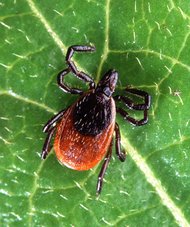Lyme disease, caused by the spirochete Borrelia burgdorferi, is the most common vector-borne illness in the United States. The vector that transmits B. burgdorferi is the deer tick (Ixodes scapularis), an inhabitant of the northeastern, southeastern, and north-central United States. (1) The deer tick also can transmit the agents of human babesiosis (Babesia microti) and ehrlichiosis (Ehrlichia chaffeensis, Ehrlichia phagocytophila, and Ehrlichia equi). (2)
Often, it is difficult to identify the important morphologic features of a tick (species, stage, and degree of engorgement) that are important in determining the risk of Lyme disease. Deer ticks have a four-stage life cycle: egg, larva, nymph, and adult. Figure 1 shows I. scapularis ticks at the nymph and adult stages, and an adult American dog tick (Dermacentor variabilis), which often is confused with the deer tick. Nymphal I. scapularis ticks (Figure 2a) transmit B. burgdorferi to humans far more frequently than adult ticks; ticks in the larva stage rarely are infected. (3) Laboratory studies have indicated that efficient transmission of this spirochete requires a minimum of 24 to 48 hours of tick attachment, at which time the nymph obviously is engorged with blood (Figure 2b). (4,5) B. burgdorferi is unlikely to infect a patient before the tick becomes engorged. D. variabilis ticks (Figure 1) are considerably larger than the I. scapularis nymph ticks and are not vectors of Lyme disease.
[FIGURES 1-2 OMITTED]
The most common sign of early Lyme disease is the hallmark rash, erythema migrans, which occurs in 80 percent of patients. (1) Erythema migrans is an intensely erythematous lesion surrounded by several concentric red rings (Figure 3), and often is accompanied by an influenza-like illness. (1) Other presenting symptoms include fatigue, myalgias, arthralgias, headache, fever, and chills. Cardiac manifestations (atrioventricular block and myocarditis) can be seen weeks to months after infection. Neurologic manifestations (aseptic meningitis, cranial neuropathy, and motor or sensory radiculoneuritis) and musculoskeletal findings (arthritis) may appear months to years later. (1)
[FIGURE 3 OMITTED]
The overall risk of acquiring Lyme disease from a deer tick bite is low, even in endemic areas. (6,7) In areas with a high incidence of Lyme disease, it may be reasonable to administer chemoprophylaxis with a single 200-mg oral dose of doxycycline (Vibramycin) to persons bitten by an I. scapularis nymph tick that is identified as being at least partially engorged with blood. (6,7) Persons who removed attached ticks within 24 hours should be observed. (1) Patients should be instructed to seek treatment if erythema migrans develops at the site of the bite. Treatment with doxycycline, 100 mg orally twice daily for 14 to 21 days, is recommended in persons who are at least eight years of age, except women who are pregnant. (1) For women who are pregnant and children less than eight years of age, amoxicillin, 500 mg orally three times daily for adults and 250 mg orally three times daily for children, should be administered for 14 to 21 days. A 14- to 21-day course of cefuroxime axetil (Ceftin), 500 mg orally twice daily in adults and 125 mg orally twice daily in children, is alternative therapy for those who may be allergic or unable to tolerate doxycycline or amoxicillin.
The authors indicate that they do not have any conflicts of interest. Sources of funding: none reported.
REFERENCES
(1.) Steere AC. Lyme disease. N Engl J Med 2001;345: 115-25.
(2.) Mylonakis E. When to suspect and how to monitor babesiosis. Am Fam Physician 2001;63:1969-74.
(3.) Matuschka FR, Spielman A. Risk of infection from and treatment of tick bite. Lancet 1993;342:529-30.
(4.) des Vignes F, Piesman J, Heffernan R, Schulze TL, Stafford KC 3d, Fish D, et al. Effect of tick removal on transmission of Borrelia burgdorferi and Ehrlichia phagocytophila by Ixodes scapularis nymphs. J Infect Dis 2001;183:773-8.
(5.) Sood SK, Salzman MB, Johnson BJ, Happ CM, Feig K, Carmody L, et al. Duration of tick attachment as a predictor of the risk of Lyme disease in an area in which Lyme disease is endemic. J Infect Dis 1997; 175:996-9.
(6.) Shapiro ED. Doxycycline for tick bites-not for everyone [Editorial]. N Engl J Med 2001;345:133-4.
(7.) Nadelman RB, Nowakowski J, Fish D, Falco RC, Freeman K, McKenna D, et al. Prophylaxis with single-dose doxycycline for the prevention of Lyme disease after an Ixodes scapularis tick bite. N Engl J Med 2001;345:79-84.
VINCENT LO RE III, M.D., University of Pennsylvania School of Medicine, Philadelphia, Pennsylvania
JAMES L. OCCI, M.S., Rutgers University, Newark, New Jersey
ROB ROY MACGREGOR, M.D., University of Pennsylvania School of Medicine, Philadelphia, Pennsylvania
VINCENT LO RE III, M.D., is a postdoctoral research fellow in the Division of Infectious Diseases at the University of Pennsylvania School of Medicine, Philadelphia, where he received his medical degree. Dr. Lo Re completed a residency in internal medicine and an infectious diseases fellowship at the Hospital of the University of Pennsylvania, where he was chief resident.
JAMES L. OCCI, M.S., currently is enrolled in a master's degree program in biology at Rutgers University, Newark, N.J. He received his undergraduate degree from Montclair State College, Montclair, N.J., and his Master of Science degrees in biology from Montclair State College and microbiology from Seton Hall University, Newark, N.J.
ROB ROY MACGREGOR, M.D., is professor of infectious diseases and director of HIV programs and clinical research at the Hospital of the University of Pennsylvania School of Medicine. He received his medical degree from Harvard Medical School, Boston, and completed a fellowship in infectious diseases at the University of Washington School of Medicine, Seattle.
Address correspondence to Vincent Lo Re III, M.D., Division of Infectious Diseases, University of Pennsylvania School of Medicine, 502 Johnson Pavilion, Philadelphia, PA 19104 (e-mail: vincent.lore@uphs.upenn.edu). Reprints are not available from the authors.
COPYRIGHT 2004 American Academy of Family Physicians
COPYRIGHT 2004 Gale Group



